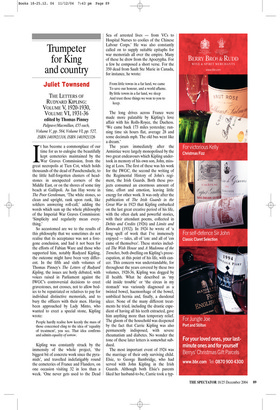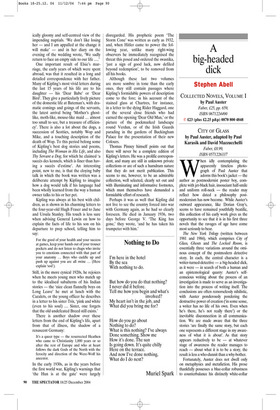Trumpeter for King and country
Juliet Townsend
THE LETTERS OF RUDYARD KIPLING: VOLUME V, 1920-1930, VOLUME VI, 1931-36 edited by Thomas Pinney Palgrave/Macmillan, £55 each, Volume V, pp. 584, Volume VI, pp. 527, ISBN 1403921318, ISBN 1403921326 It has become a commonplace of our time for us to eulogise the beautifully kept cemeteries maintained by the War Graves Commission, from the great necropolis at Tien Cot, which holds thousands of the dead of Passchendaele, to the little half-forgotten clusters of headstones in unexpected corners of the Middle East, or on the shores of some tiny beach at Gallipoli. As Ian Hay wrote in The Poor Gentleman, ‘The white stones, so clean and upright, rank upon rank, like soldiers answering roll-call,’ adding the words which sum up the whole philosophy of the Imperial War Graves Commission: ‘Simplicity and regularity mean everything.’ So accustomed are we to the results of this philosophy that we sometimes do not realise that its acceptance was not a foregone conclusion, and had it not been for the efforts of Fabian Ware and those who supported him, notably Rudyard Kipling, the outcome might have been very different. In the fifth and sixth volumes of Thomas Pinney’s The Letters of Rudyard Kipling, the issues are hotly debated, with voices raised in Parliament against the IWGC’s controversial decisions to erect gravestones, not crosses, not to allow bodies to be repatriated or relatives to pay for individual distinctive memorials, and to bury the officers with their men. Having been approached by Lady Minto, who wanted to erect a special stone, Kipling wrote: People hardly realise how keenly the mass of those concerned cling to the idea of ‘equality of treatment’, you see. That idea confirms and admits equality of sorrow.
Kipling was constantly struck by the immensity of the whole project, ‘the biggest bit of concrete work since the pyramids’, and travelled indefatigably round the cemeteries of France and Flanders, on one occasion visiting 32 in less than a week. ‘One never gets used to the Dead Sea of arrested lives — from VCs to Hospital Nurses to coolies of the Chinese Labour Corps.’ He was also constantly called on to supply suitable epitaphs for war memorials all over the empire. Many of these he drew from the Apocrypha. For a few he composed a short verse. For the 350 dead from Sault Ste Marie in Canada, for instance, he wrote:
From little towns in a far land, we came To save our honour, and a world aflame. By little towns in a far land, we sleep And trust those things we won to you to keep.
The long drives across France were made more palatable by Kipling’s love affair with his Rolls-Royce, the Duchess. ‘We came back 173 miles yesterday; running time six hours flat, average 28 and some decimals mph. The old bus went like a dream.’ The years immediately after the Armistice were largely monopolised by the two great endeavours which Kipling undertook in memory of his own son, John, missing at Loos. The first of these was his work for the IWGC, the second the writing of the Regimental History of John’s regiment, the Irish Guards. Both these projects consumed an enormous amount of time, effort and emotion, leaving little energy for other work. It was only after the publication of The Irish Guards in the Great War in 1923 that Kipling embarked on the last great creative period of his life, with the often dark and powerful stories, with their attendant poems, collected in Debits and Credits (1926) and Limits and Renewals (1932). In 1924 he wrote of ‘a long spell of work that I’ve immensely enjoyed — tales, all of ’em: and all of ’em came of themselves’. These stories included The Wish House and A Madonna of the Trenches, both dwelling on Kipling’s preoccupation, at this point of his life, with cancer. This concern was understandable, for throughout the years covered by these two volumes, 1920-36, Kipling was dogged by ill health. What he described as ‘my old inside trouble’ or ‘the circus in my stomach’ was variously diagnosed as a twisted bowel, haemorrhage of the bowel, umbilical hernia and, finally, a duodenal ulcer. None of the many different treatments he tried, including the drastic expedient of having all his teeth extracted, gave him anything more than temporary relief. The gloom of the household was deepened by the fact that Carrie Kipling was also permanently indisposed, with severe rheumatism and diabetes. No wonder the tone of these later letters is somewhat subdued.
The most important event of 1924 was the marriage of their only surviving child. Elsie, to George Bambridge, who had served with John Kipling in the Irish Guards. Although both Elsie’s parents liked her husband-to-be, Carrie took a typ ically gloomy and self-centred view of the impending nuptials. ‘We don’t like losing her — and I am appalled at the change it will make’ — and in her diary on the evening of the wedding wrote, ‘We sadly return to face an empty side to our life ....’ One important result of Elsie’s marriage, the early years of which were spent abroad, was that it resulted in a long and detailed correspondence with her father. Many of Kipling’s most vivid letters during the last 15 years of his life are to his daughter — his ‘Dear Babe’ or ‘Dear Bird’. They give a particularly lively picture of the domestic life at Bateman’s, with dramatic comings and goings of the servants, the latest arrival being ‘Mother’s ghostlike, moth-like, mouse-like maid ... almost too small to see, but a treasure of efficiency’. There is also a lot about the dogs, a succession of Scotties, notably Wop and Mike, and a touching description of the death of Wop. To this period belong some of Kipling’s best dog stories and poems, including The Woman in His Life, and also Thy Servant a Dog, for which he claimed ‘a succès des kennels, which is finer than having a succès d’estime’. An interesting point, new to me, is that the cloying baby talk in which the book was written was a deliberate attempt by Kipling to imagine how a dog would talk if his language had been wholly learned from the way a human owner talks to his or her pet.
Kipling was always at his best with children, as is shown in his charming letters to the four-year-old Hugh Fraser and to Jane and Ursula Stanley. His touch is less sure when advising General Lewin on how to explain the facts of life to his son on his departure to prep school, telling him to say:
For the good of your health and your success at games, keep your hands out of your trouser pockets and do not listen to chaps who invite you to emotions connected with that part of your anatomy ... Boys who cuddle up and push up against you are all swine ... (Here explain ‘sod’).
Still, in the more cynical 1920s, he rejoices when he meets young men who match up to the idealised subalterns of his Indian stories — the ‘nice clean flannelly boys on Long Leave’ he met at lunch with the Cazalets, or the young officer he describes in a letter to his sister Trix, ‘pink and white (even to his soul) ... Sister, one forgets that the old undefeated Breed still exists.’ There is another shadow over these letters from the end of Kipling’s life, apart from that of illness, the shadow of a renascent Germany:
It’s a queer type — the resurrected Heathen who came to Christianity 1,000 years or so after the rest of Europe and who at heart follows the dark Gods of the North with the ferocity and direction of the Were-Wolf his ancestor.
In the early 1930s, as in the years before the first world war, Kipling’s warnings that ‘the Hun is at the gate’ were largely disregarded. His prophetic poem ‘The Storm Cone’ was written as early as 1932, and, when Hitler came to power the following year, unlike many right-wing observers he immediately recognised the threat this posed and ordered the swastika, ‘just a sign of good luck, now defiled beyond redemption’, to be removed from all his books.
Although these last two volumes are more sombre in tone than the early ones, they still contain passages where Kipling’s formidable powers of description come to the fore; in his account of the stained glass at Chartres, for instance, in a letter to the dying Rider Haggard, one of the several close friends who had earned the opening ‘Dear Old Man,’ or the picture of the pockmarked landscape round Verdun, or of the Irish Guards parading in the gardens of Buckingham Palace for the presentation of their new Colours.
Thomas Pinney himself points out that there will never be a complete edition of Kipling’s letters. He was a prolific correspondent, and many are still in unknown private collections or are of such a humdrum nature that they do not merit publication. This seems to me, however, to be an admirable collection, well selected, clearly set out and with illuminating and informative footnotes, which must themselves have demanded a formidable effort of research.
Perhaps it was as well that Kipling did not live to see the country forced into war with Germany again, as he had so clearly foreseen. He died in January 1936, two days before George V. ‘The King has gone,’ they wrote, ‘and he has taken his trumpeter with him.’


















































































 Previous page
Previous page